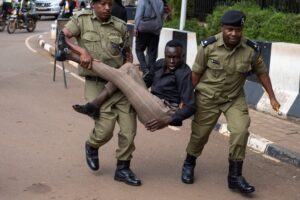Namibia Plans Wildlife Cull to Combat Hunger Amid Drought Crisis
VICTOR KIPCHUMBA August 29, 2024 0
Elephants in Halali resort Namibia.
Namibia is preparing to kill hundreds of wild animals in a desperate attempt to combat the ongoing food crisis. The drought, the worst in 100 years, has left many Namibians struggling with severe food shortages. The government hopes to feed the population by turning to its wildlife.
Government Announces Wildlife Cull
In an official statement on August 26, Namibia’s Ministry of Environment, Forestry, and Tourism confirmed the cull. The ministry plans to slaughter 723 wild animals from the country’s national parks and communal areas. Among the targeted animals are 30 hippos, 60 buffaloes, 50 impalas, 100 blue wildebeest, 300 zebras, 83 elephants, and 100 elands.
The ministry emphasized the sustainability of this move. The animals will be taken from areas with stable populations, ensuring no significant impact on biodiversity. Officials argue that this approach will reduce grazing pressure and improve water availability in these regions.
Constitutional Justification for the Cull
The government insists that this drastic measure aligns with Namibia’s constitutional mandate. According to the Ministry of Environment, using the country’s natural resources to benefit citizens is an essential duty. Officials stress that the culling of these animals will directly support Namibians during this unprecedented crisis.
“This exercise is necessary,” the ministry stated. “It allows us to fulfill our constitutional obligations while benefiting Namibians. Conservation should always serve the people, especially during hard times.”
A History of Supporting the Community
This cull is not an isolated event. The ministry has a long history of distributing game meat for national and regional events. These efforts ensure that Namibia’s wildlife serves a purpose beyond conservation, helping local communities when needed most.
Over the years, the ministry has provided meat for various events across Namibia, adhering to policies that balance conservation and public welfare. The cull, while significant, is part of an established practice of utilizing wildlife to support citizens during times of crisis.
Worst Drought in a Century
Namibia declared a state of emergency in May, as the drought’s impact intensified across the country. Thousands of families are now in dire need of food, and government officials are scrambling to address the issue.
Southern Africa has been experiencing its worst drought in decades, and Namibia is one of the hardest-hit countries. Between April and June 2024, the United Nations reported that 1.2 million Namibians faced acute food insecurity. Many of these citizens require urgent intervention to close food gaps and protect their livelihoods.
The drought has ravaged crops and livestock, leading to widespread hunger. Namibia has already depleted 84% of its food reserves, leaving the nation dangerously close to a full-blown food crisis. The government hopes that by culling wildlife, they can provide much-needed relief to their starving citizens.
Growing Tensions Over Wildlife Cull
The decision to kill hundreds of animals has sparked debate among conservationists, animal rights groups, and local citizens. Many conservationists fear that the cull could have long-term ecological consequences despite the government’s claims of sustainability.
However, others argue that the government has no other choice. Namibia’s food security is at risk, and immediate action is needed. The drought has decimated crops, left livestock emaciated, and pushed rural communities to the brink of starvation. In such a crisis, using wildlife to feed the population seems like the only viable option.
Local Leaders Support the Plan
Local leaders have voiced their support for the government’s plan. Many believe that the cull is a practical solution that will provide immediate relief to suffering communities. In rural areas where farming has collapsed, the promise of fresh meat is a welcome reprieve.
“The situation is dire,” said one community leader. “We need to take every opportunity to feed our people. The government’s plan makes sense given the circumstances.”
Although the cull has ignited fierce debates, many Namibians see it as a necessary evil in the face of unprecedented hardship.
Conservation and Crisis Management
Namibia has long prided itself on its conservation efforts, which have preserved its rich biodiversity. The country boasts a diverse range of wildlife, which attracts tourists and supports local economies. Yet, the worsening drought has forced officials to make difficult decisions to balance wildlife conservation with human survival.
The Ministry of Environment, Forestry, and Tourism believes that this cull will not disrupt the country’s conservation goals. They remain confident that Namibia’s game populations will recover, even after the planned cull.
“We have always managed our wildlife sustainably,” the ministry’s statement read. “This action, while extreme, will not compromise the health of our ecosystems.”
Global Attention on Namibia’s Crisis
The international community is paying close attention to Namibia’s drought and food crisis. Several humanitarian organizations have already pledged support, hoping to alleviate the situation before it spirals further out of control. However, critics point out that external aid alone may not be enough to resolve the crisis.
As Southern Africa continues to grapple with severe drought conditions, countries like Namibia are finding themselves at a crossroads. Wildlife, typically a symbol of national pride, is now being seen as a lifeline for desperate citizens.
Hope for Rain
With no end to the drought in sight, Namibia faces an uncertain future. Many are pinning their hopes on rain, which could restore the country’s agricultural productivity. Yet, weather forecasts remain bleak, and government officials continue to explore every possible avenue for relief.
In the meantime, the controversial cull will proceed as planned. Namibians hope that this drastic measure will buy them time and alleviate hunger until more sustainable solutions can be found.
Namibia’s decision to cull hundreds of wild animals reflects the desperate circumstances brought on by a once-in-a-century drought. The government faces enormous pressure to provide for its citizens while safeguarding its wildlife heritage. Balancing these demands has proven challenging, and the cull represents an attempt to navigate this complex crisis.
Only time will tell whether this approach will provide the relief that Namibians so desperately need. For now, the nation watches, waiting for the rains that could finally bring an end to their suffering.


